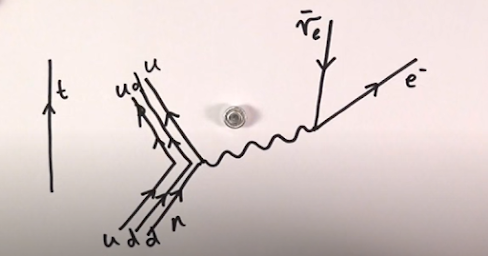Gluons
GLUONS
View my previous article here -
View the next article here -
-----------------------------------------
Just like how electrons carry the electric charge, the quarks also carry the electric charge, but this electric charge is weaker in quarks. Quarks additionally carry a coloured charge, as discussed in the previous article. This coloured charge generates a gluon force field.
An accelerating quark creates a vibrating ripple in the gluon field, which is known as gluons.
Just like how a photon can create an electron and positron (anti-electron) pair -
energetic gluon can create a quark and antiquark pair -
While the electromagnetic charge has only one version, the colour charge has 3.
But the colour charge never shows up in the hadron quark combinations. (Keep reading to find out about hadrons.) This led to the idea that the three colour charges were red, yellow and blue since they added up to a neutral white.
Gluons carry the same colour charge as quarks. Thus, gluons can interact with each other as well.
MORE ON GLUONS:
At a separation of around 10−15 m – the typical size of a proton or neutron – the force of attraction between a pair of quarks is equivalent to the weight of a 10-tonne truck!The strong force of attraction between two up quarks is much larger than the electric force of repulsion between them. It is this strong force that prevents quarks from being liberated in high-energy collisions.
Free quarks are never seen to emerge from such processes: quarks only exist confined within baryons or mesons. It is as if they are stuck together with very strong glue.
When high-energy beams of electrons collide with equally high-energy beams of positrons travelling in the opposite direction, it often happens that hadrons emerge as a pair of jets, with each jet made up of several hadrons.
By now, you must be thinking, what are these hadrons, baryons and mesons?
Hadron is defined as a subatomic particle made of quarks, gluons and anti-quarks. Hadrons are the heaviest particles. It is composed of two or more quarks that are held strongly by electromagnetic force.
Every individual quark has functional electric charges, these combine such that hadrons carry a net integer electric charge. The simple two ways are three quarks of different colours or a quark of one colour and an antiquark that has a corresponding anticolour. Hadrons under the first arrangement are known as baryons and those under the second arrangement are called mesons.
Baryons: It is made up of three coloured quarks.
Mesons: It is made up of 1 quark and 1 anti-quark.
The basic interaction that produces the pair of jets is as follows.
First, the electron (e−) and positron (e+) annihilate each other and produce what is known as a virtual photon.
The reason for this name is that the virtual photon only has a temporary existence and immediately undergoes a pair creation event, giving rise to a quark-antiquark pair. Their kinetic energy and mass-energy are almost immediately converted into the kinetic energy and mass energy of many more matter and antimatter particles, including lots more quarks and antiquarks.
The many quarks and antiquarks then combine to form a variety of hadrons, and it is only the hadrons that then emerge from the collision as a pair of jets.
But, sometimes three jets may be produced. This process involves the gluon. Gluons are the quanta of energy whose emission and absorption are regarded as the origin of strong interactions. (In physics, a quantum is the minimum amount of any physical entity involved in an interaction.) They are responsible for ‘glueing’ the quarks strongly together inside hadrons. However, unlike photons – but like quarks and antiquarks – gluons cannot escape to large distances.
Nonetheless, a quark (or indeed an antiquark) may emit a gluon. The mass-energy and kinetic energy of the gluon is quickly turned into the mass-energy and kinetic energy of further pairs of quarks and antiquarks. These in turn combine with each other to form various hadrons, and the hadrons produced from the gluon then give rise to a third jet emerging from the process.

An electron and a positron mutually annihilate each other to create a virtual photon which subsequently creates a quark-antiquark pair. The energy of the quark and antiquark are then transformed into many more quarks and antiquarks, which give rise to a pair of jets of hadrons.

An electron and a positron mutually annihilate each other to create a virtual photon which subsequently creates a quark-antiquark pair. The quark emits a gluon, shown by the curly line. The energy of the quark, antiquark and gluon are then transformed into many more quarks and antiquarks, which give rise to three jets of hadrons.
-----------------------------------------
View the next article here -
View my previous article here -
View a more structured order of the articles here -
-----------------------------------------
Feel free to ask/share anything additional in the comments section!
I am still learning Particle physics, but will try my best to answer your questions :)
Kindly let me know about any errors here.
Kindly let me know about any errors here.
You can also share anything additional for this article here.
View my previous article here -
View the next article here -
View a more structured order of the articles here -
See more articles here -
Solve brain teasers! View my other blog here-
With Warm Wishes,
Lavanya




Comments
Post a Comment